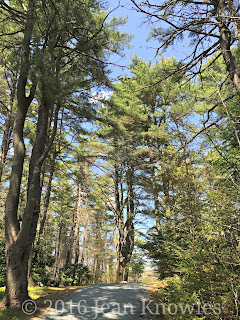 |
| Puffin on Gull Island, Witless Bay |
It's that time of year again -- the puffins and other seabirds have returned to their colonies around the coasts of Atlantic Canada and Maine. There are many places around the region to see these small, sturdy birds, but two locations stand out: the Witless Bay Ecological Reserve for sheer numbers, and the Puffin Island at Elliston for land-based observation.
The Witless Bay Ecological Reserve lies south of St. John's, Newfoundland and Labrador. Witless Bay takes its name from an early family of settlers, the Whittles family; over the years the name has been corrupted to its present form. The four islands of the reserve lie just off the shore, from north to south they are Gull Island, Green Island, Great Island, and the fancifully named Peepee Island, whose name is said to be from the distinctive aroma that wafts from it in summer.
 |
| Typical "puffin weather" at Elliston |
There are boat tours that allow for a closer approach to the islands; to protect the bird life, only those operators granted special permits are allowed to travel through the reserve. Bay Bulls is the primary starting point for these excursions, while operators can also be found in the town of Witless Bay and in Mobile, just to the south. All Witless Bay photos in this post are thanks to
Captain Wayne's Marine Excursions of Bay Bulls. Other operators can be found
here.
Puffins are true pelagics: they land on these rocky islands solely to mate and rear their young, spending the remainder of the year on the open sea. They burrow into the dirt of the island, or on rockier sites use narrow clefts in the rock for burrows. The pairs bond for life, returning to the same burrow year after year, although "divorces" are said to occur if one mate is a less-than-stellar provider. They're not the only seabirds that nest in the Reserve; there are also black-legged kittiwakes, common and thick-billed murres, black guillemots, and huge numbers of Leach's storm petrels among others.
 |
| Burrow entrance |
Elliston, located on the Bonavista Peninsula, is the self-styled Root Cellar Capital of North America due to the large number of these storage structures that can be found there. Just outside the community is a headland accessed by a rocky trail that leads to a viewing point overlooking a small island that houses a breeding colony of puffins. The unusual thing about this spot is that when the weather and wind are right (often damp weather and a southeast wind) the puffins will land near the viewing area on the headland itself. This makes for some incredible up-close viewing experiences.
The puffins will be around until late August, with a few lingering into September, so there's plenty of opportunity for a good look during the summer months. Happy viewing!



























